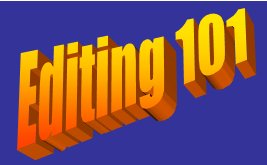 Congratulations! You’ve just finished your project or story. Now what?
Congratulations! You’ve just finished your project or story. Now what?
Well, you’re probably going to want to read through it again, and make changes before you make your final submission.
The tendency for inexperienced authors is to either give their writing a “once-over” before they submit it or send a copy to their friend, parent, or boyfriend to look it over. These writers will often believe that they’ve taken on the role of an editor to polish their work, but have they?
Let’s look at this from a different aspect. You are writing an article for a newspaper and let’s say you have some experience doing so. You’re working within tight deadlines, and to make sure you’re fitting within the style guidelines for your article you revise some text. Is this editing?
Semantically, “revisions” and “editing” may seem the same, but they’re really not. When a writer re-reads his (or her) work to make changes: that may qualify as a “revision.” An editor’s role is often multi-layered and the professional ones often wear many hats–regardless of the industry the editor is working in.
An Editor’s Role
What does an editor do? Well, many editors look at the work from a 10,000 foot view once it’s submitted, to ensure that the content fits the goal of the publication. Let’s look at an example of how this might work. Say you’ve been hired by a non-profit agency to write a grant proposal. Once your work has been submitted, an editor will read it over to ensure that it meshes with the business’ expectations of what a proposal should look like, and whether or not it best represents their agency. In this way, a professional editor is required to understand the market not from an individual “project” perspective, but from an aggregate view of those projects.
Next, an editor may provide feedback to the writer based on how their work fits into the overall scheme of a business. Here’s where a style guide can come into play. A decent style guide may often provide a writer with insight around consistent messaging for their project, appropriate definitions or industry language, and consistency around style, etc. Often, writers are required to read a style guide up front but it’s also the editor’s responsibility to make sure that it fits.
For a creative project, the editor may look at how marketable a novel is based on their experiences of what sells and what doesn’t for that particular publisher. This view is vital to any publishing house’s success, because it’s something that many authors cannot possibly gleam without “working on the inside.” Financial data may often help an editor understand what market the publishing house is reaching, and can help them categorize where a writer’s work may fit for shorter-term and longer-term planning. When submitting speculative work, writers often get confused because rejection letters seem so impersonal. Often times, there may be absolutely nothing “wrong” with a writer’s story–it just doesn’t “fit” the overall umbrella of that publication. Editors know this, but unfortunately many writers don’t, causing them to take rejection rather poorly.
Some editors will provide written feedback based on the story in the rejection letter. A good practice for a writer is to read up on that magazine or anthology to know whether or not their work fits the publication. Other times, it may be appropriate to take a chance when there is no clear “answer.”
Whether you’ve dealt with an editor or not, editing often requires a separate set of skills than writing does because there is often a larger picture at stake. When you do have an editor on a project that you’re working on, remember that their goal is to ensure that the publication is the best it realistically can be–which is great for everyone involved.
That is not to say that some authors also provide a layer of editing to their own work or that editors don’t write; in a perfect world the two would be mutually exclusive. As we all know, it is not a perfect world. Editors often have multiple titles as well, so if you’re ever wondering what your particular editor will do for you–don’t be afraid to ask.
Tomorrow I’m going to talk about the difference between editing for content and copy editing and how both may affect your work.



Comments are closed.